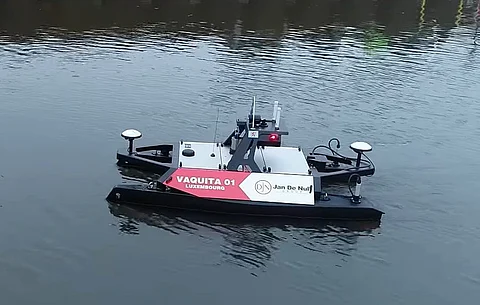

Dredging and marine works company the Jan De Nul Group has introduced a new unmanned surface vehicle (USV) to be used for hydrographic surveys in inland waters.
Developed by Norwegian unmanned systems company Maritime Robotics, Vaquita 01 has a length of two metres, a beam of 1.08 metres, a draught of 0.3 metre, a height of 1.07 metres, and a displacement of 55 kilograms. These attributes enable the craft to operate safely in narrow channels with bridges and other low-having structures.
A catamaran design provides enhanced stability while the integrated bathymetric survey sensors include multi-beam sonars for seabed scanning and a laser scanner for surface assessments. Other sensor options include acoustic Doppler current profilers, CTD sensors, fluorometers, and hyper spectral imagers depending on operational requirements.
Four interchangeable battery packs supply power to a Torqeedo motor to propel the craft to a maximum speed of three knots or operate for up to 28 hours at one knot. The batteries will allow full-day survey missions without recharging, and the use of off-the-shelf components means the operator can easily source spare parts should the batteries or their associated equipment require maintenance or replacement.
The USV is controlled via a graphical user interface in the form of either Maritime Robotics' proprietary vehicle control station (VCS) or a mobile device app. The app provides manual joystick-like control, while the VCS has several control modes, such as course and speed control, heading control, or waypoint control. For waypoint control, the operator can easily plan missions consisting of individual waypoints, or use templates for creating common patterns such as lawnmower surveys. Live monitoring of sensor data quality parameters and visualisation of actual data are provided in the VCS, and sensor parameters can also be adjusted.
The communication between the USV and the operator can be via smartphone wifi over a range of 100 metres, extended wifi over 300 metres, or 4G for global operations. Launch and recovery can be performed via slipway or davit, whether shore-based or from a trailer.
The craft is also fitted with a forward-looking camera and standard marine navigation lights.
Jan De Nul said Vaquita 01 can be used in all phases of a dredging project, from the tender phase before the project itself begins to evaluation upon completion of works.
| Vaquita 01 | |
| SPECIFICATIONS | |
| Type of vessel: | USV – Survey |
| Owner: | Jan De Nul Group, Luxembourg |
| Builder: | Maritime Robotics, Norway |
| Length overall: | 2.0 metres |
| Beam: | 1.08 metres |
| Draught: | 0.3 metre |
| Displacement: | 55 kilograms |
| Main engine: | Torqeedo |
| Maximum speed: | 3.0 knots |
| Batteries: | 4 |
| Other electronics: | Laser scanner |
